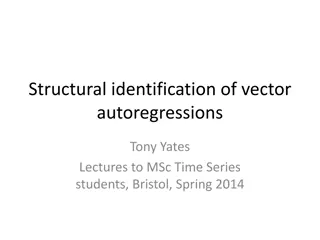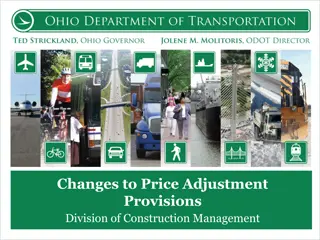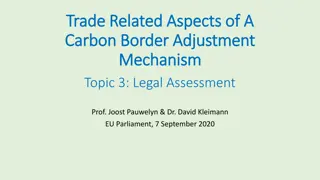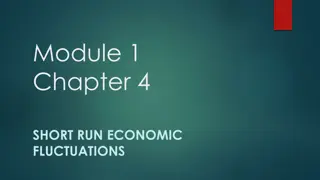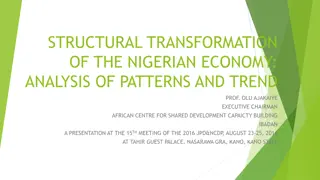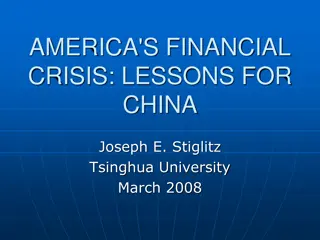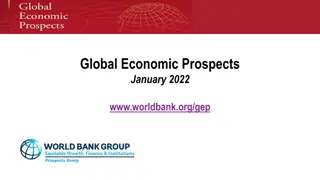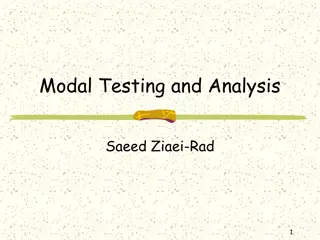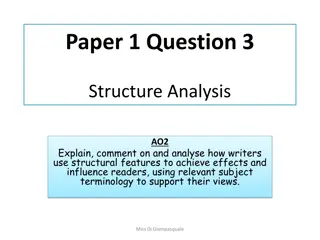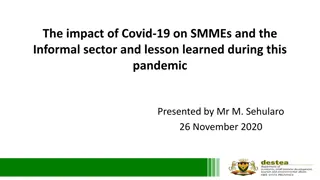Consequences of Structural Adjustment and Economic Slowdown
Structural adjustment programs have led to a slowdown in the average rate of economic growth, transitioning through phases of deflation and recovery. This has impacted industrial performance, agricultural sector growth, and rural employment. The reforms have resulted in a shift towards stabilization but have also led to a decline in expansionary stimuli, affecting various sectors of the economy.
Download Presentation

Please find below an Image/Link to download the presentation.
The content on the website is provided AS IS for your information and personal use only. It may not be sold, licensed, or shared on other websites without obtaining consent from the author. Download presentation by click this link. If you encounter any issues during the download, it is possible that the publisher has removed the file from their server.
E N D
Presentation Transcript
Slowdown in the Average Rate of Economic Growth The first notable consequence of structural adjustment has been a slowdown in the average rate of economic growth relative to the preceding five years. It may be argued that Fund-Bank-style reforms are inevitably associated with deflation in the short run, and it is only after a while that the economy is expected to pick up on the basis of stimuli other than those that prevailed under the dirigiste regime. Thus, a transitional period of stagnation is expected and should not cause undue worry, provided growth subsequently picks up on a new basis.
Two Distinct Phases in the Post-reform Period In the case of India, then, there are two distinct phases in the post-reform period, a phase of deflation, during which the goal for the economy was stabilization, and a subsequent phase of recovery, starting from 1993-94. It is now clear, however, that this recovery was a result of transient phenomena, the stepping up of the fiscal deficit in 1993-94 and, even after the fiscal deficit had been lowered in the subsequent years, the satisfaction of pent-up demand for a variety of hitherto- unavailable luxury consumer goods. Since the rate of growth of the demand for such goods is much lower, the stimulus that such demand imparts to industrial production evaporates quickly. This is exactly what has happened.
Dismal Industrial Performance in 1997- 98 Industrial performance has been dismal in 1997-98. As a result, compared to an average annual growth rate of 8.4 percent in the index of industrial production during the period 1985-86 to 1990-91, the rate for the seven years 1990-91 to 1997-98 comes to 5.9 percent. This slowing down clearly is a secular phenomenon, not just a short-term consequence of stabilization. It is an expression of the loss of expansionary stimulus that a liberalized economy entails, through the decline of public investment, through higher interest rates, and through the shrinkage of demand owing to import liberalization.
Slowdown in the Agricultural Sector A slowdown is also evident in the agricultural sector, where the growth in the production of food grains in particular has declined sharply. For a long time now the Indian economy has experienced a secular growth rate of food grain production of around 2.5 percent per annum, a little higher than the population growth rate. Even during the 12-year period 1978-79 to 1990-91 (both of which were good agricultural years), the rate of growth of food grain production was 2.4 percent, which was above the population growth rate. However, over the period 1990-91 to 1996-97 (again both good agricultural years), the growth rate of food grain production dropped to 1.4 percent, distinctly lower than the population growth rate. So India was witnessing the emergence of a serious food crisis.
Impact on Rural Workers and Employment The purchasing power among the workers, especially the rural workers, has increased even more slowly in real terms. The reason for this lies partly in the steep escalation in administered prices of food, which occurred in the aftermath of structural adjustment as part of the so- called fiscal correction (for which subsidies had to be kept down), and partly in the shift of emphasis toward export agriculture and away from food crops. Food grain production is more employment intensive than the exportable commodities that substitute for it in terms of land use, such as Prawn fisheries, sunflower, orchards, etc. Thus, a shift of acreage from the former to the latter that occurs as a sequel to liberalization has the effect of restricting employment growth.
Impact(contd.) This explains inter alia both the decline in food grain output growth and the decline in employment growth. There is, however, an additional factor behind the drop n food grain output growth: real public investment in agriculture has drastically declined over a long period. Public investment being employment generating the decline in public investment has adversely affected employment scenario. There has been an overall stagnation of the investment ratio of which this decline is a part. This sluggish investment performance is not surprising. The proposition underlying neo-liberal policies that if only more surplus value is handed over to the capitalists they would automatically invest more, is a myth.
The rolling back of State Capitalism Not-effective The rolling back of state capitalism, far from increasing the investment ratio, causes its stagnation and even decline. A reduction in the revenue deficit, or in the fiscal deficit, can be brought about in a number of different ways, the obvious one being an increase in direct tax revenue. Indeed in any Third World economy where glaring poverty coexists with offensive opulence, increased revenue from direct taxes is urgently called for anyway as a means of reducing inequalities. But the Fund and Bank invariably underplay this avenue of deficit reduction and emphasize cuts in investment and welfare expenditures.
Invalid Theory Underlying Cuts in Investment and Welfare Expenditures Not only is the theory underlying such cuts invalid, but the fiscal deficit that is invoked to legitimize such cuts gets aggravated because of structural adjustment. Since inviting foreign direct investment becomes an overriding objective of economic policy, the rates at which it is taxed get reduced in competition with other countries. Thus structural adjustment, which supposedly aims to restrict the fiscal profligacy of the state, itself works to further aggravate the fiscal situation through lower taxes on the rich and higher interest rates. Not surprisingly then, fiscal adjustment leaves the size of the revenue deficit unchanged, and it impinges heavily on public investment and welfare expenditures.
Rise in Rural Poverty Another significant consequence of structural adjustment has been a rise in rural poverty. One element underlying the rise in rural poverty was the sharp increase in the cost of living of the working class in general and of agricultural workers in particular. This acceleration of inflation in a period of slack demand was essentially due to hikes in administered prices, which were ordered by the government in order to curtail its subsidy bill, and thereby the fiscal deficit. The commodity whose price was most severely affected in this manner was food grains. There were steep hikes in the central issue prices of rice and wheat in December 1991, January 1993, and February 1994.
Rise in(contd.) As a consequence of these hikes, by February 1994 the issue price of the common variety of rice had increased by 86 percent compared to the immediate pre-structural adjustment level; wheat had increased by 72 percent. It is hardly surprising that the cost of living of the workers, both in urban and rural areas, went up so sharply, and that the cost of living of agricultural labourers, for whom food is an even more important item in the consumption basket than for industrial workers, went up more steeply than for the latter.
Rural Poverty and Employment Opportunities There was a second element underlying the rise in rural poverty. The level of rural poverty is linked in India not only to the level of food prices relative to wages, but even more pronouncedly to the magnitude of employment opportunities. There has been an accentuation of unemployment, notably in rural India, in the nineties, owing to the shift acreage from food to nonfood crops, import liberalization that has led to a demand switch away from domestic producers, and, above all, cuts in public development expenditure.
Rural Poverty(contd.) The central government s total development expenditure as a proportion of GDP at market prices declined from 12.54 percent in 1985-86 to 8.08 percent in 1995-96 and 7.74 percent in 1996-97. Since government expenditure has a crucial employment generating effect, especially in rural areas, this reduction has been employment contracting. Accompanying this increase in poverty there has been a cut in the ratio of social sector expenditure to GDP. The effect of structural adjustment is evident not just in the fact of stagnation or growing poverty and unemployment or the growing desperation in wooing MNCs to overcome infrastructural shortages. It is evident above all in the increased vulnerability to speculation of the Indian economy.
Rural Poverty(contd.) Most of the Foreign Direct Investment (FDI) inflows has come into activities catering to the domestic market, which displace domestic producers and constitute implicit deindustrialization (owing to the high import content of FDI production). It would have helped India s cause had it come into activities such as export-oriented production which genuinely add to domestic output and employment. Finally, many had believed that a retreat of the state and the exposure of the economy to the discipline of the market would cut out arbitrariness of decision making and the corruption that is inevitably associated with it.
Concluding Observation It was also believed that retreat of the state would streamline the functioning of the economy by making it a rule-governed system, though admittedly the rules of the market. What has happened instead in the Indian economy during this period of structural adjustment is an increase in the level of corruption, cronyism, and arbitrariness to unprecedented levels. Precious natural resources, hitherto kept inside the public sector, are handed over for a pittance (and alleged kickbacks ) to private firms with dubious objectives.
Concluding(contd.) The case of the Enron deal, where massive contracts were signed without an open tender and at inflated capital costs, with guaranteed rates of return, has already attracted international attention. So the discipline of the market has proved to be a chimera. Long ago Lenin had also pointed out that finance capital is associated with swindles, bribery, and corruption, or what European professors of his time condescendingly called the American ethics.






